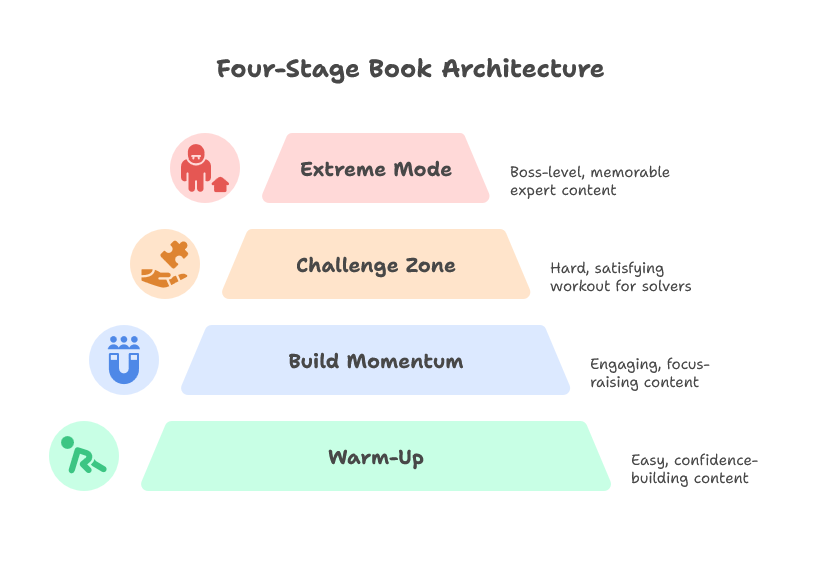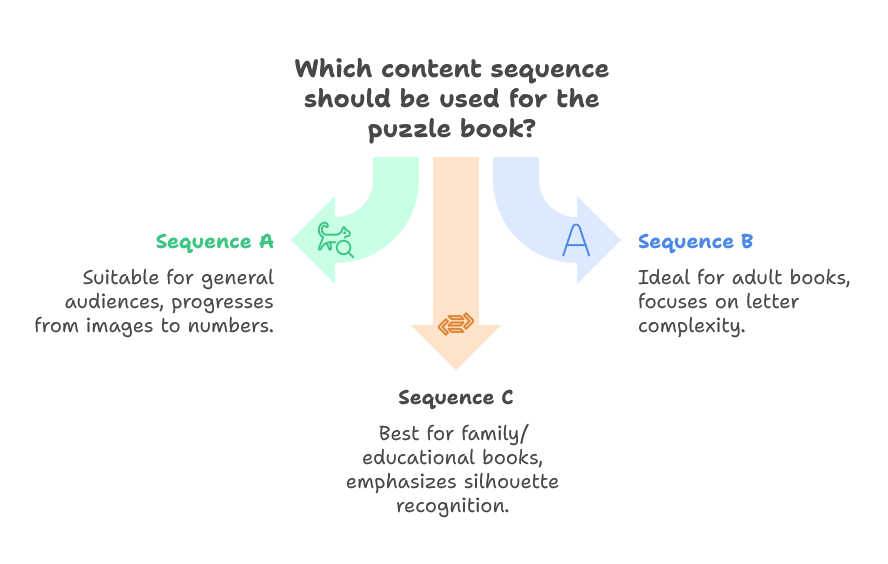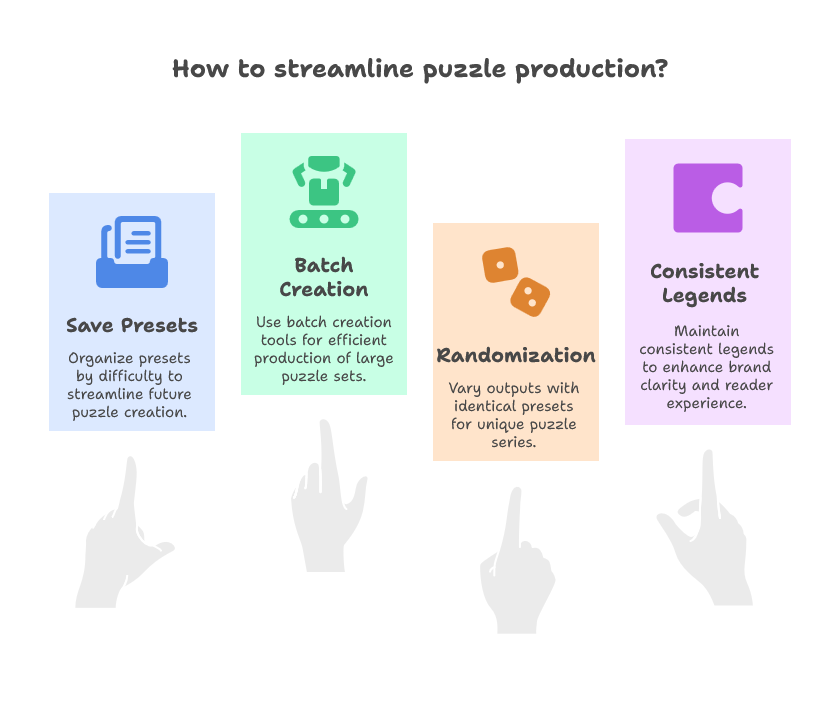How to Structure a Complete Seek and Find Puzzle Book for Print: From Simple to Complex (and Extreme)
A practical blueprint for pacing, variety, and reader delight — without relying on color.
Why structure matters more than you think
Most puzzle books lose readers in the middle. Not because the puzzles are bad, but because the difficulty curve is flat or the variety is lumpy. Seek and Find shines when your audience feels early wins, steady momentum, and a few “boss‑level” moments before a satisfying finish.
You’re designing more than pages; you’re designing a journey. The right structure builds confidence, sustains curiosity, and turns casual solvers into fans who finish the book (and buy the sequel). That’s great design — and great business.
This guide outlines a proven framework for print‑first, black‑and‑white Seek and Find books. It assumes one content type per puzzle (as Seek and Find generates): images (silhouettes or line art), letters, or numbers. We’ll use orientation (rotation/mirroring), symbol similarity, fill density, and spacing to move from friendly to fiendish — cleanly, fairly, and without color.
The two curves you must manage
Think of your book as two braided curves:
- Difficulty curve — how hard the puzzles feel over time.
- Variety curve — how fresh each new section feels (content type, theme, visual style).
If difficulty rises but variety doesn’t, the middle starts to feel repetitive. If variety spikes but difficulty stalls, advanced readers get bored. The sweet spot: steady difficulty + rhythmic variety.
Difficulty levers you’ll use repeatedly
- Grid scope: larger grids = longer scans = harder overall feel.
- Fill density & spacing: denser symbols and tighter spacing raise effort.
- Noise/decoy ratio: more near‑miss symbols raise attention demands.
- Orientation: rotation (30°/45°/90°) and mirroring add cognitive load.
- Symbol similarity: similar silhouettes or confusable letters/digits increase scrutiny.
- Legend clarity: consistent, readable legends keep puzzles “hard but fair.”
Variety levers
- Content type by section: images → letters → numbers (or any sequence).
- Theme within content type: animals, tools, leaves, etc.
- Visual style: filled silhouettes vs. outline line art.
A four‑stage book architecture (that readers love)

Design the book in four distinct stages. Each stage has a purpose and a mood.
Stage 1 — Warm‑Up (Easy, Confidence‑Building)
Intent: Immediate wins, clear rules, inviting look.
- Typical content: bold silhouettes or upright uppercase letters.
- Levers: small/medium grids, low density, minimal decoys, no rotation/mirroring.
- Legend: large examples, plain language (“Find and count…”).
- Reader outcome: “I can do this.” They turn the page with momentum.
Stage 2 — Build Momentum (Medium, Engaging)
Intent: Raise focus without breaking flow.
- Typical content: simple line art, letters with light rotation, or numbers with generous spacing.
- Levers: medium grids, moderate density, moderate decoys, limited rotation.
- Reader outcome: Each page asks a bit more; satisfaction increases.
Stage 3 — Challenge Zone (Hard, Satisfying)
Intent: Deliver a real workout for attentive solvers.
- Typical content: similar silhouettes (e.g., leaf families), letters with mirroring, numbers with look‑alike pairs (6/9, 2/5).
- Levers: large grids, higher density, higher decoys, rotation + mirroring, tighter spacing.
- Reader outcome: Deep focus, slower pace — but still fair and readable.
Stage 4 — Extreme Mode (Boss‑Level, Memorable)
Intent: Give experts what they came for — clean, tough, conquerable.
- Typical content: letters/numbers with multiple confusables plus rotation/mirroring; silhouette sets with near‑identical outer contours.
- Levers: largest practical grids, near‑max density, high decoys, tight spacing (no collisions).
- Reader outcome: A “final boss” feeling; finishing brings pride and a desire for your next volume.
Pro move: Insert a short “Mixed Round” (2–4 pages) between stages to help readers adjust — part recap, part preview of what’s next.
How many puzzles per stage? (scalable templates)
Use these editorial splits to create a pleasing arc. Adjust counts as needed.
Compact (60 puzzles)
- Warm‑Up: 15
- Build Momentum: 15
- Challenge Zone: 20
- Extreme: 10
Standard (96–100 puzzles)
- Warm‑Up: 20–22
- Build Momentum: 24–26
- Challenge Zone: 30–32
- Extreme: 14–16
Large (120+ puzzles)
- Warm‑Up: 24–28
- Build Momentum: 30–32
- Challenge Zone: 38–42
- Extreme: 18–22
Why this spread? Because most readers spend the most time — and feel the most satisfaction — in the Challenge Zone. It deserves the biggest footprint.
Sequencing the variety curve (content type across the book)

Remember: Seek and Find uses one content type per puzzle. Use this to your advantage. A few reliable sequences:
Sequence A — Images → Letters → Numbers
- Warm‑Up: silhouettes (animals, tools, leaves).
- Build Momentum: letters (upright + light rotation).
- Challenge Zone: letters with mirroring, or numbers with confusables.
- Extreme: numbers + letters (still one per puzzle), both with mirroring/rotation.
Sequence B — Letters‑First (for adult books)
- Warm‑Up: uppercase letters, upright only.
- Build Momentum: mixed letter families with lightweight rotation.
- Challenge Zone: mirror pairs (b/d/p/q, M/W, N/Z).
- Extreme: multiple confusable sets + rotation/mirroring + density.
Sequence C — Silhouette‑Forward (family/education)
- Warm‑Up: bold silhouettes, generous spacing.
- Build Momentum: line art with distinct patterns (dots, hatching).
- Challenge Zone: similar silhouettes (two birds, different profiles).
- Extreme: very similar contours + rotation (no ambiguity, but demanding).
Tip: Tie themes to stages (e.g., Oceans → Forest → Desert → Mountains), or keep one theme per book and escalate only by difficulty. Both approaches work; choose based on your brand plan.
Rhythm, “breathers,” and boss‑level pages
Even top solvers fatigue. Strategic pacing keeps them in flow.
- Breather pages: After two hard pages, insert a slightly easier one. It’s not a setback; it’s good pacing.
- Anchors: Place one signature puzzle (memorable theme or clever twist) at the end of each stage. Readers remember these anchors — and they’re ideal for promo images.
- Boss puzzles: Reserve 1–3 “this is it” challenges for the final section. They should be hard, but not unfair. If your page depends on an ambiguity, redesign it.
Legends, instructions, and fairness
Clarity is part of your brand promise. Keep it consistent:
- Legend language: Keep it short and repeatable (“Find and count…”).
- Legend examples: Show targets at a comfortable size; never rely on color language in a B/W book.
- Fairness checks:
- No touching/overlapping symbols.
- Orientation variation is fine; the symbol identity must be unmistakable.
- If it’s confusable even for you at print size, change it.
Solutions that actually help (and build trust)
Readers want closure. Good solution pages reduce support messages and increase ratings.
- Numbering: Every puzzle number appears exactly on its solution.
- Clarity over compactness: One solution per page is the safest choice; two per page is fine if still readable.
- Legend echo: Re‑show target identity if space allows (especially for letter/number sets with mirroring).
Place solutions at the back for clean reading flow.
Three example book outlines (ready to copy)
Use these as starting points; swap themes/content types to match your audience.
Outline 1 — Family Friendly (96 puzzles, silhouettes → letters)
- Warm‑Up (22): bold animal silhouettes, upright, low density.
- Build Momentum (24): uppercase letters with light rotation (45°), moderate spacing.
- Challenge Zone (32): leaf silhouettes with similar contours; then letters with mirroring (b/d/p/q).
- Extreme (18): letters with mirroring + tighter spacing; insert one “Numbers: 6 vs 9” finale as the ultimate boss.
Why it works: clear on‑ramp, variety without whiplash, and a memorable finish.
Outline 2 — Adult Brain‑Teaser (100 puzzles, letters → numbers)
- Warm‑Up (20): uppercase letters only, upright; introduce occasional narrow forms (I, J) for focus.
- Build Momentum (26): letters with rotation (90°); a few confusables introduced, spacing still fair.
- Challenge Zone (32): mirror pairs, high decoy ratio, larger grids.
- Extreme (22): mixed confusables (M/W, N/Z, b/d/p/q) and numbers (6/9, 2/5) in separate puzzles; very tight spacing; strict fairness checks.
Why it works: the audience expects intensity; letters then numbers increase novelty while keeping identity rules consistent.
Outline 3 — Education‑First (120 puzzles, silhouettes/line art focus)
- Warm‑Up (28): big silhouettes (animals, classroom objects), low density.
- Build Momentum (30): line art with distinct interior patterns; occasional rotation for older students.
- Challenge Zone (40): similar silhouettes (e.g., tools, leaves), higher decoys, moderate rotation.
- Extreme (22): numbers (no color cues) with rotation; final “mixed silhouettes” set with close contours (still fair).
Why it works: teachers get a wide spectrum of pages, from stations and warm‑ups to end‑of‑unit challenges.
Production planning with Puzzle Maker Pro – Seek and Find

Keep it conceptual; your process can be streamlined with a few habits:
- Save presets by stage (e.g., “Silhouettes — Easy,” “Letters — Medium 90°,” “Numbers — Extreme”).
- Batch creation when possible. The Creator Edition adds Time Saver for large batches and additional layout options if you want multi‑puzzle pages; the standard module’s Instant Puzzle Books reliably outputs one puzzle per page, which suits B/W interiors well.
- Randomization is your friend. Even with identical presets, outputs vary — perfect for series or larger books.
- Consistent legends across every preset reduce reader friction and reinforce your brand’s clear, fair tone.
As always, export puzzle and solution separately (JPG/PNG/PDF) and compile with your preferred layout workflow. Keep your structure doc handy while assembling so the arc stays intact.
Quality gates that protect your reviews
Before you finalize interiors, run these checks:
- Print test: One page per stage on a basic printer. If anything drops out or looks cramped, it will be worse at scale.
- Solve‑time spot checks: A 30–60 second skim per puzzle can reveal unintended spikes in difficulty.
- Edge cases: Look specifically for collisions and ambiguous silhouettes; confirm that mirrored forms are still identifiable as the same symbol.
- Solution audit: Numbers match, targets marked cleanly, no missed decoys.
These guardrails do more than polish — they build trust with readers and reduce returns.
Series planning and catalog strategy
Structure isn’t just for one book; it’s a system you can extend:
- Two‑volume arcs: Book 1 = Warm‑Up → Build Momentum → Light Challenge; Book 2 = Quick Warm‑Up → Challenge → Extreme.
- Theme branches: Create parallel series (e.g., Animals, Tools, Letters) using the same four‑stage architecture.
- Seasonal or occasion editions: Holiday silhouettes or “new year brain reset” adult editions.
- Brand moments: Place your signature “boss puzzle” style at the end of every book to create a recognizable calling card.
Tie this to your marketing plan (samples in listings, interior previews that showcase the arc, and cross‑links to sequels).
Common mistakes (and the fix)
- Monotone difficulty: If pages 20–60 feel the same, insert breathers and mini‑spikes to restore rhythm.
- Unclear legends: If support emails mention “I wasn’t sure what to count,” enlarge the legend examples and simplify wording.
- Ambiguity masquerading as difficulty: When two silhouettes are indistinguishable at print size, it isn’t “hard” — it’s unfair. Swap symbols or add separation.
- Whiplash variety: Jumping from kids‑easy silhouettes to extreme numbers in one page turn confuses readers. Use Mixed Rounds to transition.
Conclusion: A journey readers will finish (and recommend)
A well‑structured Seek and Find book reads like a good playlist: a warm introduction, rising energy, a big middle, and a finale you remember. Use the four‑stage architecture, tune your difficulty and variety curves, and protect the experience with clear legends and fair design. Your readers will feel guided — and they’ll come back for the next volume.
Build your next book faster — with professional consistency.
Explore Puzzle Maker Pro – Seek and Find and shape your four‑stage book with reusable presets, randomization, and print‑ready exports.
https://www.bookpublishertools.com/product/puzzle-maker-pro-seek-and-find/
Further Reading
- Designing Seek and Find Puzzles for Every Age Group
- Beyond Word Searches: Adding Visual Puzzles to Your KDP and Etsy Books
- How to Build a Complete Puzzle Book Using Seek and Find Themes
- Creating Accessible and Inclusive Puzzles
Written to your house style (BrandStory + JTBD, educational tone, soft CTA), following your Core Copywriting Style Guide and Article Copywriting Guide, and aligned with your Core Marketing Strategy 2025 audience segmentation and funnel goals.
